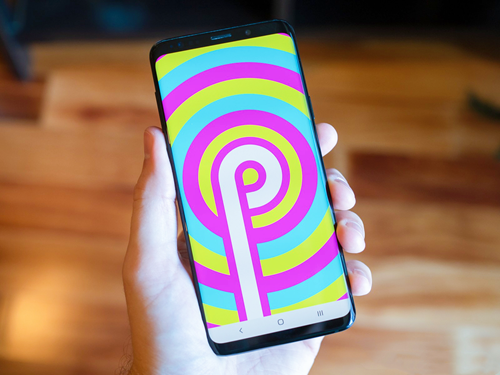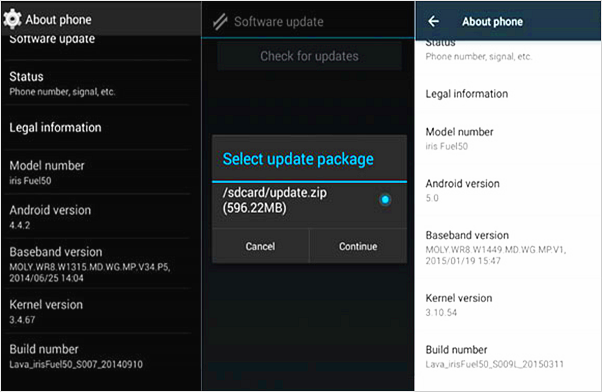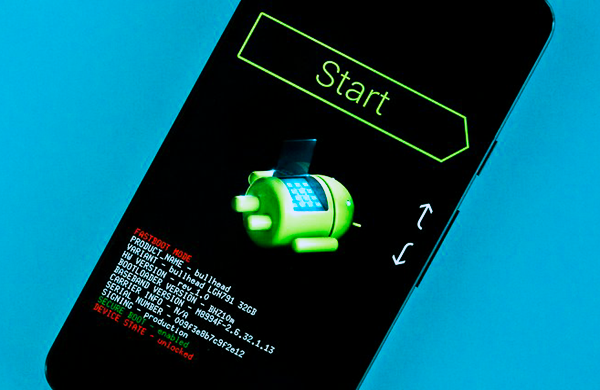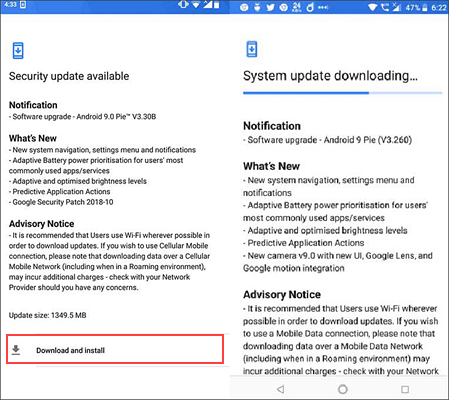How to Update Your Currently Android Version to Latest Android 9.0 Pie
How to Update Your Currently Android Version to Latest Android 9.0 Pie
The Android operating system is constantly updated, and each update brings a different experience to the user. From Android 1.0 to Android 9.0, it has made major breakthroughs in vision, concept, and functionality. But the constant is that each generation of Android OS has a corresponding dessert code, Android 5.0 is Lollipop, Android 6.0 is Marshmallow, Android 7.0 is Nougat, Android 8.0 is Oreo, and Android 9.0 is Pie. So what are the features of Android Pie? How can we quickly get Android P update? Next, this article will give a detailed explanation and three ways to update the Android version.

Benefits of Android System Update (Android 9.0 Features):
- Adaptive battery and brightness
- Intelligent prediction & Intuitive navigation
- Multi-camera and Bluetooth connections support
- Convenient Do Not Disturb mode
- Daily view of the time spent on your phone
- Set time limits for the apps you use
- Features with High Dynamic Range (HDR) VP9 Profile 2
- New gesture control interface with no back button and multitasking button
……

Now that you’ve known the awesome features of Android 9.0 Pie, you may can’t wait to upgrade your current Android version to the latest Android version. However, the Android system update is not as simple as you think. Even if you’ve read a lot of tutorials, you will find that most of them are too complicated to understand. To serve your needs, here I’ll introduce three simple and effective ways to update your Android version, there is always a way that works for you.
- Method 1. How to Upgrade Android Version with OTA Updates
- Method 2. How to Update Android Version with Upgrade Package
- Method 3. How to Upgrade Android Version with Rooting Device
Method 1. How to Upgrade Android Version with OTA Updates
Normally, you will get notifications from OTA (over-the-air) when the Android Pie update is available for you. From here, you can open it and tap the update action to upgrade the Android system to the latest version. However, if for whatever reason, it isn’t being rolled out to your phone or you accidentally cleared the notification, then you need to update Android version manually:
- Connect your Android phone to the Wi-Fi Network.
- Go to Settings > About device, then tap System Updates > Check for Updates > Update to download and install the latest Android version.
- Your phone will automatically reboot and upgrade to the new Android version when the installation completed.
Method 2. How to Update Android Version with Upgrade Package
Under ordinary conditions, the official website of mobile phone manufacturers will update some system files for users to download and upgrade. You can go to the download center of your Android phone’s official website, and then download the latest system upgrade package according to your phone’s brand model. After the download is completed, please store it in the phone’s SD card.
To update the Android OS version, you need to negative to Settings > About Phone > System Update, once your phone shows the available package, tap Continue to download and install the package. After rebooting, your phone will be updated to the Android 9.0 Pie automatically.

Method 3. How to Upgrade Android Version with Rooting Device
Rooting is an extremely powerful approach to update your Android system. If you need to upgrade to the latest Android OS version when it’s accessible, you could try to root your phone, which can not only enable you to attain super administrator permissions over various Android subsystems but also access updates effortlessly.
As for how to root the Android phone, just follow the detailed instructions:
- Download and install a root app on your computer.
- After running it, connect your phone to the computer via a USB cable.
- Root your phone by following the corresponding prompts.
- Reboot your phone to access the latest version of the Android operating system.

How to Install Android Q Beta on Your Phone
Android 9.0 is the sublimation of the previous Android operating system version. Although it is perfect, developers have not stopped developing new Android versions, in order to bring a better experience to users.
Android Q, also known as Android 10, is bound to outperform Android 9.0. Currently, the release date of Android Q is uncertain, but there are some rumors about its function. Do you want to know what features Android Q has? Read Everything About Android 10 Q.
Google has recently rolled out its Android Q beta version for the users which will help users and different smartphone manufacturers to get an idea about the next-gen Operating System which will be rolled out in Google phones later this year. But to get involved with this Android Q version, you need a Pixel smartphone which should be very helpful for you to get your task done.
Android Q phones − How to download the Android Q beta
All versions of the Android Q beta have been available to users of the following phones:
All versions of the Android Q beta have been available to users of the following phones:
- Google Pixel
- Google Pixel XL
- Google Pixel 2
- Google Pixel 2 XL
- Google Pixel 3
- Google Pixel 3 XL
Google has offered Android Q version on selected models of Google Pixel but now after the 7th of May, Google has released a list of different smartphones that are manufactured by different brands of Smartphones which can be used to get Android Q in them. There are very fewer models that are currently supported with the Android Q version, but this list will get expanded very soon, mentioned in the press statement released by Google itself. This (Android Q beta version) is a pre-release version and these updates have been rolled so as to provide a rough idea to the users about the upcoming Android Q.
But before you do anything in your smartphone, you need to create the backup of all your data because according to the statement released by Google, you may lose your data while installing the Android Q version. So, to get on a safe side, we personally recommend you to back up your device data on a safe storage place.
To get Android Q in your smartphone, you need to follow some guidelines by visiting this page − you’ll see the option to opt in and accept the Android Beta Program Terms of Service. Once you’ve completed the enrolment process, you’ll start receiving regular over-the-air updates to the latest Android Q beta builds.
As of May 7, you can also download the Android Q beta on the following non-Google devices:
- Asus ZenFone 5Z − instructions here
- Essential Phone − instructions here
- Huawei Mate 20 Pro − instructions here
- LG G8 − instructions here
- Nokia 8.1 − instructions here
- OnePlus 6T − instructions here
- Oppo Reno − instructions here
- realme 3 Pro − instructions here
- Sony Xperia XZ3 − instructions here
- Tecno Spark 3 Pro − instructions here
- Vivo X27 − instructions here
- Vivo Nex S − instructions here
- Vivo Nex A − instructions here
- Xiaomi Mi 9 − instructions here
- Xiaomi Mi MIX 3 5G − instructions here
You will also feel some significant changes in the display of the OS, for example, you will see a different texture of apps display, smooth functioning of your smartphone, etc.
Most of the big smartphone manufacturers like OnePlus, Samsung, Xiomi, Sony and Nokia will take complete benefits as they will roll out the Android Pie updates to the users in very little time. The Android Q updated will surely be a huge success for Google as far the tech experts think. And we too stand in the favor of this statement and will suggest you use this Android Q version on your phone. All you need to do is just see the list of the compatible devices released by the Google and get sign up (different smartphones have a different set of instructions) to get the updates of this Android Q beta version. So, just check your eligibility now and get these updates right on your smartphone.
You can find Google’s list of known issues here.
As Google explains: “The updates that you’ll receive as a part of this program are pre-release versions, and may contain errors and defects that can affect the normal functioning of your device.
“The current release contains significant behavior changes that affect apps in particular. The latest updates around isolated storage may cause issues with apps that access photos, videos, media, or other files stored on your device, such as when browsing or sharing in social media apps.
You will not be able to unenroll and revert back to a lower public release version of Android without first wiping all locally saved data on your device. You may also encounter issues restoring a backup.”
How to Set Up an Android Q Beta Emulator
You can also try the Android Q beta out using the official Android Emulator. To try it out this way, Google says you should do the following:
- In Android Studio, select Tools > SDK Manager
- In the SDK Platforms tab, select Show Package Details
- Below Android Q Beta, select a system image such as Google APIs Intel x86 Atom System Image
- In the SDK Tools tab, select the latest version of Android Emulator, and select OK
- Select Tools > AVD Manager and follow the instructions to create a new Android Virtual Device
- Be sure to select a device definition that does not include Play Store, and select Q for the system image
- When you return to the AVD Manager’s list of virtual devices, double-click your new virtual device to launch it
How to Opt-Out of the Android Q Beta
If you sign up to the Android Q beta but come to regret your decision, you can leave − but this comes at a price.
“If you opt out when your device is running a beta version of Android, all user data on the device will be wiped,” says Google. “If you choose to stay enrolled until the end of the program, you will graduate from the program and receive an update to the stable public release of Q. Your device will not be wiped.”
When Does the Android Q Launch
Google says there will be six beta versions in total, with the main Android Q release planned for Q3 2019 (between July and September).
- Beta 1 (initial release, beta)
- Beta 2 (incremental update, beta)
- Beta 3 (incremental update, beta)
- Beta 4 (final APIs and official SDK, Play publishing, beta)
- Beta 5 (release candidate for testing)
- Beta 6 (release candidate for final testing)
- Final release to AOSP and ecosystem
Have you signed up for the Android Q beta? What are your early impressions?
Make a Backup before Upgrading Android System
The above are three ways to update the Android OS version, have you learned? If yes, please don’t hesitate to share it with your family and friends, so you can enjoy all the new features brought by Android 9.0 with them.
By the way, no matter which method you choose, it is suggested to back up all the important data in your phone on your computer to prevent accidental data loss. Of course, if you lose data after upgrading the Android version without backing up, it doesn’t matter, because there is a free data recovery software that allows you to recover deleted or lost data without backup, that’s phonechris Andriod data recovery. With it, you can easily restore deleted contacts, messages, call logs, photos, music, videos, and other files from your phone memory or SD Card with original quality guaranteed.

Comments
Post a Comment